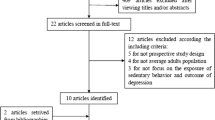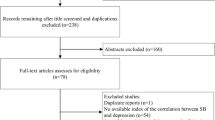Abstract
Background
Physically inactive lifestyles and sedentary behaviors (SB) are key contributors to ill health. Although the association between SB (e.g., watching TV/using the computer) and physical health has been well documented, increasing research has focused on the possible link between SB and mental health (e.g., depression).
Purpose
This review aims to investigate the effect of SB on the risk of depression in adults.
Method
A systematic search for original research articles investigating associations between SB and depression in adults was performed using the several electronic data bases.
Results
A total of seven observational and four intervention studies were included in this review. All observational studies found positive associations between SB and risk of depression, while intervention studies showed contradictory results.
Conclusion
Evidence for the relationship between SB and risk of depression in adults is limited by methodological weaknesses. However, on balance, this review suggests that SB is associated with an increased risk of depression. Further studies are needed assessing different types of SB and depression; the interrelationship between physical activity, SB, and depression; causal links between SB and depression; and intervention strategies aimed at reducing SB and their effects on risk of depression.
Similar content being viewed by others
References
Panagiotakos DB, Polystipioti A, Polychronopoulos E. Prevalence of type 2 diabetes and physical activity status in elderly men and women from Cyprus (the MEDIS Study). Asia Pac J Public Health. 2007;19:22–8.
Manson JE, Rimm EB, Stampfer MJ, Colditz GA, Willett WC, Krolewski AS, et al. Physical activity and incidence of non-insulin-dependent diabetes mellitus in women. Lancet. 1991;338:774–8.
Eriksson KF, Lindgarde F. Prevention of type 2 (non-insulin-dependent) diabetes mellitus by diet and physical exercise. The 6-year Malmo feasibility study. Diabetologia. 1991;34:891–8.
Pan XR, Li GW, Hu YH, Wang JX, Yang WY, An ZX, et al. Effects of diet and exercise in preventing NIDDM in people with impaired glucose tolerance. The Da Qing IGT and Diabetes Study. Diabetes Care. 1997;20:537–44.
Manson JE, Hu FB, Rich-Edwards JW, Colditz GA, Stampfer MJ, Willett WC, et al. A prospective study of walking as compared with vigorous exercise in the prevention of coronary heart disease in women. N Engl J Med. 1999;341:650–8.
Morris JN, Everitt MG, Pollard R, Chave SP, Semmence AM. Vigorous exercise in leisure-time: protection against coronary heart disease. Lancet. 1980;2:1207–10.
Blair SN, Kohl 3rd HW, Paffenbarger Jr RS, Clark DG, Cooper KH, Gibbons LW. Physical fitness and all-cause mortality. A prospective study of healthy men and women. JAMA. 1989;262:2395–401.
Leon AS, Myers MJ, Connett J. Leisure time physical activity and the 16-year risks of mortality from coronary heart disease and all-causes in the Multiple Risk Factor Intervention Trial (MRFIT). Int J Sports Med. 1997;18 Suppl 3:S208–15.
Haapenan N, Miilunpalo S, Pasanen M, Oja P, Vuori I. Association between leisure time physical activity and 10-year body mass change among working-aged men and women. Int J Obes. 1997;21:288–96.
Coakley EH, Rimm EB, Colditz G, Kawachi I, Willett W. Predictors of weight change in men: results from the Health Professionals Follow-up Study. Int J Obes Relat Metab Disord. 1998;22:89–96.
Dosemeci M, Hayes RB, Vetter R, Hoover RN, Tucker M, Engin K, et al. Occupational physical activity, socioeconomic status, and risks of 15 cancer sites in Turkey. Cancer Cause Control. 1993;4:313–21.
Hirose K, Tajima K, Hamajima N, Takezaki T, Inoue M, Kuroishi T, et al. Subsite (cervix/endometrium)-specific risk and protective factors in uterus cancer. Jpn J Cancer Res. 1996;87:1001–9.
Teychenne M, Ball K, Salmon J. Physical activity and likelihood of depression in adults: a review. Prev Med. 2008;46:397–411.
Paluska SA, Schwenk TL. Physical activity and mental health. Sports Med. 2000;29:167–80.
Commonwealth Department of Health and Aged Care. National health priority areas report: mental health 1998. Canberra: Commonwealth Department of Health and Aged Care; 1999.
Greden JF. The burden of recurrent depression: causes, consequences, and future prospects. J Clin Psychiatry. 2001;62:5–9.
Ainsworth BE, Haskell WL, Whitt MC, Irwin ML, Swartz AM, Strath SJ, et al. Compendium of physical activities: an update of activity codes and MET intensities. Med Sci Sports Exerc. 2000;32:S498–504.
Owen N, Leslie E, Salmon J, Fotheringham MJ. Environmental determinants of physical activity and sedentary behavior. Exerc Sport Sci Rev. 2000;28:153–8.
Clark BK, Sugiyama T, Healy GN, Salmon J, Dunstan DW, Owen N. Validity and reliability of measures of television viewing time and other non-occupational sedentary behaviour of adults: a review. Obes Rev. 2009;10:7–16.
AC Nielsen Company. Nielsen report on television. New York: A.C. Nielsen Company; 2000.
Australian Bureau of Statistics. How Australians use their time. Canberra: Commonwealth of Australia; 1998.
Office for National Statistics. 2000 and 2005 Time use survey. 2006. http://www.statistics.gov.uk/cci/nugget.asp?id=7. Accessed 13 Jan 13 2008.
U.S. Bureau of Labor Statistics. American time use survey—2007 results. 2008. http://www.bls.gov/tus. Accessed 13 January 2008.
National Association for Sport and Physical Education. Adults/teens attitudes toward physical activity and physical education. Sports J. 2003;6.
Dunstan DW, Salmon J, Healy GN, Shaw JE, Jolley D, Zimmet PZ, et al. Association of television viewing with fasting and 2-h postchallenge plasma glucose levels in adults without diagnosed diabetes. Diabetes Care. 2007;30:516–22.
Hu FB, Li TY, Colditz GA, Willett WC, Manson JE. Television watching and other sedentary behaviors in relation to risk of obesity and type 2 diabetes mellitus in women. JAMA. 2003;289:1785–91.
Dunstan DW, Salmon J, Owen N, Armstrong T, Zimmet PZ, Welborn TA, et al. Physical activity and television viewing in relation to risk of undiagnosed abnormal glucose metabolism in adults. Diabetes Care. 2004;27:2603–9.
Cameron AJ, Welborn TA, Zimmet PZ, Dunstan DW, Owen N, Salmon J, et al. Overweight and obesity in Australia: the 1999–2000 Australian Diabetes, Obesity and Lifestyle Study (AusDiab). Med J Aust. 2003;178:427–32.
Kronenberg F, Pereira MA, Schmitz MK, Arnett DK, Evenson KR, Crapo RO, et al. Influence of leisure time physical activity and television watching on atherosclerosis risk factors in the NHLBI Family Heart Study. Atherosclerosis. 2000;153:433–43.
Jakes RW, Day NE, Khaw KT, Luben R, Oakes S, Welch A, et al. Television viewing and low participation in vigorous recreation are independently associated with obesity and markers of cardiovascular disease risk: EPIC-Norfolk population-based study. Eur J Clin Nutr. 2003;57:1089–96.
Dunstan DW, Salmon J, Owen N, Armstrong T, Zimmet PZ, Welborn TA, et al. Associations of TV viewing and physical activity with the metabolic syndrome in Australian adults. Diabetologia. 2005;48:2254–61.
Ford ES, Kohl 3rd HW, Mokdad AH, Ajani UA. Sedentary behavior, physical activity, and the metabolic syndrome among U.S. adults. Obes Res. 2005;13:608–14.
Lotan M, Merrick J, Carmeli E. A review of physical activity and well-being. Int J Adolesc Med Health. 2005;17:23–31.
O'Neal H, Dunn AL, Martinsen EW. Depression and exercise. Int J Sport Psychol. 2000;31:110–35.
Brosse AL, Sheets ES, Lett HS, Blumenthal JA. Exercise and the treatment of clinical depression in adults. Sports Med. 2002;32:741–60.
Azar D, Ball K, Salmon J. The association between physical activity and depressive symptoms in young women: a review. Ment Health Phys Act. 2008;1:82–8.
Penedo FJ, Dahn JR. Exercise and well-being: a review of mental and physical benefits associated with physical activity. Curr Opin Psychiatr. 2005;18:189–93.
Lawlor DA, Hopker SW. The effectiveness of exercise as an intervention in the management of depression: systematic review and meta-regression analysis of randomised controlled trials. BMJ. 2001;322:1–8.
Thomee S, Eklof M, Gustafsson E, Nilsson R, Hagberg M. Prevalence of perceived stress, symptoms of depression and sleep disturbances in relation to information and communication technology (ICT) use among young adults—an explorative prospective study. Comput Hum Behav. 2007;23:1300–21.
Dittmar ML. Relations among depression, gender, and television viewing of college students. J Soc Behav Pers. 1994;9:317–28.
Sanchez-Villegas A, Ara I, Guillen-Grima F, Bes-Rastrollo M, Varo-Cenarruzabeitia JJ, Martinez-Gonzalez MA. Physical activity, sedentary index, and mental disorders in the SUN Cohort Study. Med Sci Sports Exerc. 2008;40:827–34.
Morgan C, Cotten SR. The relationship between internet activities and depressive symptoms in a sample of college freshmen. Cyberpsychol Behav. 2003;6:133–42.
DiNardo JE, Pischke J. The returns to computer use revisited: have pencils changed the wage structure too? Q J Econ. 1997;112:291–303.
von Elm E, Altman DG, Egger M, Pocock SJ, Gotzsche PC, Vandenbroucke JP. Strengthening the Reporting of Observational Studies in Epidemiology (STROBE) statement: guidelines for reporting observational studies. BMJ. 2007;335:806–8.
Moher D, Schulz KF, Altman DG. The CONSORT statement: revised recommendations for improving the quality of reports of parallel-group randomized trials. Ann Intern Med. 2001;134:657–62.
Singh AS, Mulder C, Twisk JW, van Mechelen W, Chinapaw MJ. Tracking of childhood overweight into adulthood: a systematic review of the literature. Obes Rev. 2008;9:474–88.
Chin APMJ, van Uffelen JG, Riphagen I, van Mechelen W. The functional effects of physical exercise training in frail older people: a systematic review. Sports Med. 2008;38:781–93.
Kraut R, Kiesler S, Boneva B, Cummings J, Helgeson V, Crawford A. Internet paradox revisited. J Soc Issues. 2002;58:49–74.
Beck AT, Steer RA. Beck depression inventory. Philadelphia: Center for Cognitive Therapy; 1978.
Radloff LS. The CES-D scale: a self reported depression scale for research in the general population. Appl Psychol Meas. 1977;1:385–401.
Kleinke CL. The depression coping questionnaire. J Clin Psychol. 1988;44:516–26.
Sidney S, Sternfeld B, Haskell WL, Jacobs Jr DR, Chesney MA, Hulley SB. Television viewing and cardiovascular risk factors in young adults: the CARDIA study. Ann Epidemiol. 1996;6:154–9.
Kraut R, Patterson M, Lundmark V, Kiesler S, Mukopadhyay T, Scherlis W. Internet paradox. A social technology that reduces social involvement and psychological well-being? Am Psychol. 1998;53:1017–31.
Sanchez A, Norman GJ, Sallis JF, Calfas KJ, Rock C, Patrick K. Patterns and correlates of multiple risk behaviors in overweight women. Prev Med. 2008;46:196–202.
Shaw LH, Gant LM. Users divided? Exploring the gender gap in internet use. Cyberpsychol Behav. 2002;5:517–27.
Lewinsohn PM. A behavioral approach to depression. Washington: Hemisphere Publishing; 1974.
Brummett BH, Mark DB, Siegler IC, Williams RB, Babyak MA, Clapp-Channing NE, et al. Perceived social support as a predictor of mortality in coronary patients: effects of smoking, sedentary behavior, and depressive symptoms. Psychosom Med. 2005;67:40–5.
Sugiyama T, Salmon J, Dunstan DW, Bauman AE, Owen N. Neighborhood walkability and TV viewing time among Australian adults. Am J Prev Med. 2007;33:444–9.
Sugiyama T, Healy GN, Dunstan DW, Salmon J, Owen N. Is television viewing time a marker of a broader pattern of sedentary behavior? Ann Behav Med. 2008;35:245–50.
Graves L, Stratton G, Ridgers ND, Cable NT. Energy expenditure in adolescents playing new generation computer games. Br J Sports Med. 2008;42:592–4.
Acknowledgments
Megan Teychenne is supported by a National Heart Foundation of Australia Postgraduate Public Health Scholarship (PP 07M 3388). A/Prof Kylie Ball is supported by a National Health and Medical Research Council Senior Research Fellowship. A/Prof Jo Salmon is supported by a National Heart Foundation of Australia Career Development Award and Sanofi-Aventis.
Author information
Authors and Affiliations
Corresponding author
Rights and permissions
About this article
Cite this article
Teychenne, M., Ball, K. & Salmon, J. Sedentary Behavior and Depression Among Adults: A Review. Int.J. Behav. Med. 17, 246–254 (2010). https://doi.org/10.1007/s12529-010-9075-z
Published:
Issue Date:
DOI: https://doi.org/10.1007/s12529-010-9075-z




